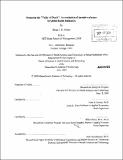| dc.contributor.advisor | Ernst R. Berndt and David Berry. | en_US |
| dc.contributor.author | Miller, Brian L. K | en_US |
| dc.contributor.other | Harvard University--MIT Division of Health Sciences and Technology. | en_US |
| dc.date.accessioned | 2010-04-28T17:06:15Z | |
| dc.date.available | 2010-04-28T17:06:15Z | |
| dc.date.copyright | 2009 | en_US |
| dc.date.issued | 2009 | en_US |
| dc.identifier.uri | http://hdl.handle.net/1721.1/54591 | |
| dc.description | Thesis (S.M.)--Harvard-MIT Division of Health Sciences and Technology, 2009. | en_US |
| dc.description | Cataloged from PDF version of thesis. | en_US |
| dc.description | Includes bibliographical references (p. 80-84). | en_US |
| dc.description.abstract | Many early-stage biotech companies face a significant funding gap when trying to develop a new drug from preclinical development to a proof of concept clinical trial. This funding gap is sometimes referred to as the "valley of death", a reflection of the vast number of companies that are unable to raise the needed capital to progress into the clinic. The suggestion behind the "valley of death" phrase is that companies that should be able to attract investment do not get funded, because (1) the technical risks inherent in taking a new drug through clinical trials are high, (2) a significant amount of capital is needed to finance clinical development, and (3) the time horizon of investment is on the order of 6-8 years. Ultimately, the valley of death reflects the perceived imbalance of risk and reward for an investment at this stage as well as the resulting difficulty for a biotech company in raising capital during this time. For companies focused on a neglected disease, this risk/reward profile is even more skewed, with significantly greater market risks and fewer exit opportunities for an investor. As a result, the "valley of death" phenomenon for a global health company developing a therapeutic for a neglected disease is even more pronounced As a result, private sector funding for translational research of neglected disease therapeutics has beeri severely lacking. In an effort to spur more private sector investment into the development of neglected disease therapeutics, several market design mechanisms have been developed including Advanced Market Commitments (AMCs) and Priority Review Vouchers (PRVs). These market design mechanisms are new and unproven. | en_US |
| dc.description.abstract | (cont.) To date venture capital has not yet flowed in a meaningful way into startup companies focusing on neglected diseases. This is partially attributable to uncertainties surrounding the credibility and value of the incentives, but it also raises the question of whether these incentives will be sufficient to attract venture investment to a small biotech company focused on neglected diseases. The objective of this thesis is to explore the potential impact of these market design mechanisms on the financial prospects of early stage, pre-revenue biotech companies focused on neglected diseases, including an evaluation of whether the incentives will be sufficient to attract venture investment to the company. To accomplish this, a simulation model was created to compare the relative impacts of these incentive schemes on a small biotech company focused exclusively on a neglected disease therapeutic. The simulation data presented herein reflect the inherent tensions between the social benefit of a neglected disease therapeutic and the need for investors to pursue a financial return commensurate with the risk of the investment. I conclude that, while market design mechanisms like PRVs and AMCs are an intriguing first step, a dual market strategy is likely still necessary for a neglected disease company to attract private investment. | en_US |
| dc.description.statementofresponsibility | by Brian L. K. Miller. | en_US |
| dc.format.extent | 93 p. | en_US |
| dc.language.iso | eng | en_US |
| dc.publisher | Massachusetts Institute of Technology | en_US |
| dc.rights | M.I.T. theses are protected by
copyright. They may be viewed from this source for any purpose, but
reproduction or distribution in any format is prohibited without written
permission. See provided URL for inquiries about permission. | en_US |
| dc.rights.uri | http://dspace.mit.edu/handle/1721.1/7582 | en_US |
| dc.subject | Harvard University--MIT Division of Health Sciences and Technology. | en_US |
| dc.title | Financing the "Valley of Death" : an evaluation of incentive schemes for global health businesses | en_US |
| dc.type | Thesis | en_US |
| dc.description.degree | S.M. | en_US |
| dc.contributor.department | Harvard University--MIT Division of Health Sciences and Technology | |
| dc.identifier.oclc | 586002574 | en_US |
